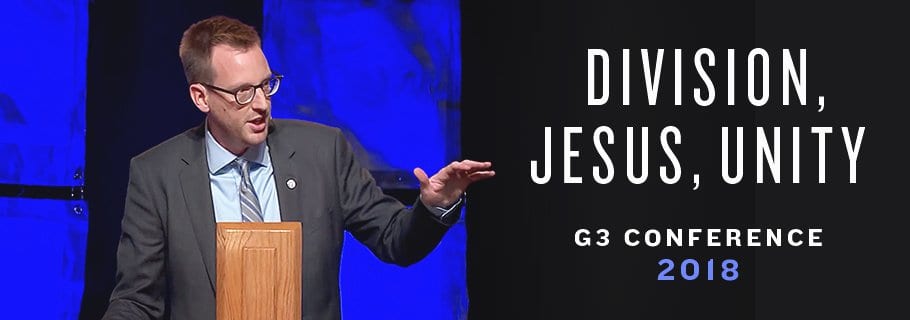At this year’s G3 Conference I had the opportunity to share some of the lessons my church has learned as we’ve grown into a congregation that reflects many different kinds of diversity. In this video I explain how one passage has been meaningful to us.
Transcript
You know in the first section of Ephesians 2, Paul talks about how people become Christians. Then in the rest of the chapter, he starts to discuss how God takes those Christians and He combines them into these communities that we call churches. And he essentially tells us a story here that unfolds in three scenes. And if we had all day, I’d really want to dive into this and unpack this. As it is, our time is short so, I’m going to focus really on how it applies to us, today.
And that first thing we come to, we might title something like, division. It begins right at the beginning, verse 11 there. So Paul is speaking to, largely to believers here. And he asks them to do something. He asks them to think back in time, to before God extended His grace to them, before they were saved. He tells the church, remember. Think back to who and what you were before God’s miraculous work in your life. He wants them to remember, he wants them to remember first, that they were divided. In that state there was deep division, Jews and Gentiles were divided from one another. The Jews, they looked down on the Gentiles and they slurred them with that word you see in there, the uncircumcision. It was very, very much an us and them mentality, where the Jews looked down on the Gentiles and the Gentiles looked down on the Jews. Humanity was divided from humanity. But it was even worse than that. Humanity was divided from God. And we see this unfold. Paul uses these really poignant words. Verse 12, remember that at that time, you were separated from Christ. They were separated from Christ, separated from all the goodness and all the grace that is in Jesus Christ. They were also alienated. They were separated, they were also alienated. Alienated from the commonwealth of Israel. God dispensed His blessings, His covenant blessings to those who are citizens of His nation, and they were not citizens of His nation. Therefore they were strangers. Strangers to the covenant of promise. It makes sense, verse 12 then, that they were hopeless. They had no hope at all in the world. And finally, worst of all, they were godless, they were without God. These people had forsaken God and been forsaken by God. That’s an ugly scene. It’s an ugly place to begin a story. Do you see the horrifying state that these people were in? Do you see the horrifying state that we are in without Christ? Scorned, separated, alienated, strangers, hopeless, godless. That’s them, that’s you, that’s me. Paul wants them to remember all this. Remember when that was their state, that was their condition. Why? Because this is the great leveling. It reminds each one of us, we are all so deeply, deeply sinful. There’s no people, there’s no nation, there’s no person that stands above any other. If we are to enjoy any blessings at all, especially if we’re to enjoy that gift of unity amid diversity, it must, must be a gift of God’s grace. God must act, God must move somehow. And so that first scene is one of humanity divided from God and therefore humanity divided from humanity.
Then the curtain falls and the curtain rises on a second scene and this scene is simply of Jesus. Simply of Jesus Christ and His life and His death and His resurrection. We come to these two precious little words. But now. But now, verse 13. But now in Christ Jesus. So we’re making a sudden leap here. We’re going from the past to the present. To the way things were, to the way things they are now. Verse 13, but now in Christ Jesus, you who once were far off have been brought near by the blood of Christ. You see God did not leave us in that state of warfare and that state of alienation. He sent His Son. He sent His Son to reconcile us to God and to reconcile us to one another. That vertical reconciliation, it brought about a horizontal reconciliation.
See if you can pick up the theme in the next few verses. Verse 14, He Himself is our peace, who has made us both one. Verse 15, that He might create in Himself one new man in place of the two. Verse 16, that He might reconcile us both to God in one body, through the cross, thereby killing the hostility. Do you see what he was driving at here? This work of Jesus is all about unity. The work of Jesus is about making us one. Which means that there’s still division between us. It’s proof that we just haven’t fully worked out the implications of the Gospel. In the death and the resurrection of Jesus Christ, God created one new race. God created one new people. And this one supersedes all others. This means the core of our identity is not Jew, it’s not Gentile. It’s not black or white or male or female or culture or place of origin. None of that. The core of our identity. The one thing that unites us in the deepest, most substantial way is Jesus Christ. See, all those other distinctions still exist and they still matter. God has a glorious purpose in two genders. God has a glorious purpose in many races. God has a glorious purpose in myriad ethnicities. God’s purpose is not to destroy distinction, but to destroy division. See, His purpose is not to promote uniformity, but to promote unity. Our only hope for true and deep and lasting unity, unity in diversity, is the Gospel of Jesus Christ. And God receives all the glory. God receives all the glory when He so transforms people that those deep divisions that once held them apart, they’re now just thrown aside, they’re swept away in this great torrent of love. So our second scene is Jesus.
Then we move to scene number three. The curtain falls, and it rises on a third scene. A scene of unity. United humanity. You see the flow in the story? You see how it’s being told? We have division and then we have Jesus and then we have unity. Verse 19 begins with, so then. On the basis of what Christ did, so then, here are the implications, here’s how this works out in your life. Here’s how this works out in the church of Jesus Christ. The scene gives us these three vivid images that we need to fix in our minds. Three vivid images to stare at, to look at, to meditate on. It’s like that curtain has risen, and before us is a great stage. And on that stage there are different sets. On the left of the stage, we’ve got a nation with its citizens. At one time there were two groups in this country. This country had citizens, they were the insiders and it had strangers and aliens, those were the outsiders. And these two groups in that one country were deeply, deeply divided from one another. But now the strangers and aliens, they’ve been drawn in. They’ve been granted every right and every privilege that comes with citizenship. They’re full citizens of this nation. And now the whole nation together stands there before their King. They’re equally standing there, honoring, praising Him. There was division, there was Jesus, there’s unity.
On the other side of the stage, we’ve got a family. We have a nation with its citizens here. Over here we’ve got a family, a Father, and His children. And we learn that some of these children standing before their Father, some of them are adopted, some of them are biological. Both are completely equal in the eyes of their Father. Both are equally loved. Equally treasured. Equally cherished. Equally precious. The inheritance of the Father, it’s equally divided among each and every one of them. That’s God’s household. There was division. Then there was Jesus. And now unity.
Then we look to the center of the stage and there’s this great building there. This was once just chaos. Just isolated bricks and stones and building material just scattered around this construction site. Now, it’s a temple. Now it’s a temple worthy of God Himself. The apostles, the prophets, they’re the foundation upon which it’s built. Through their inspired instruction, they’re its foundation. Jesus Christ, he’s the cornerstone, the stone that holds it all together. You take that stone away, it will collapse, it will be malformed. What’s this temple made of? Us. It’s made up of us, all of us. We are the stones, we are bricks that make up the temple. From isolated bits of building material to this gorgeous temple. There was division, there was Jesus, there’s unity.
So there are our three scenes. We’ve got a nation assembled before it’s King. A family gathered before its loving Father. And a temple that’s been constructed as the dwelling place of God Himself. What has God done? He’s taken us from division, all the way to unity and He’s done it all through the Lord Jesus Christ.










